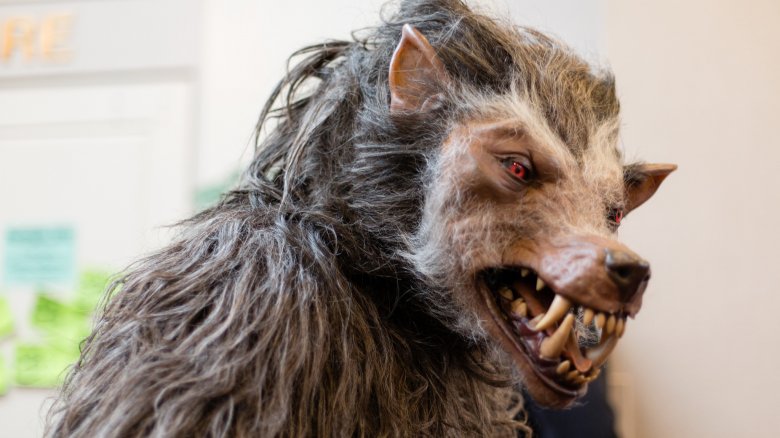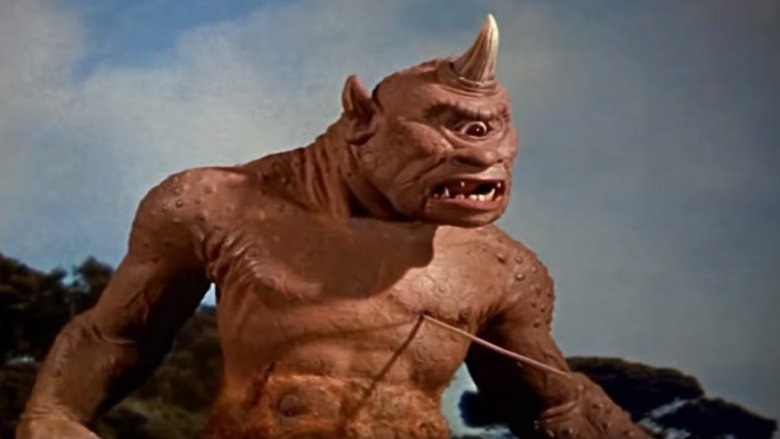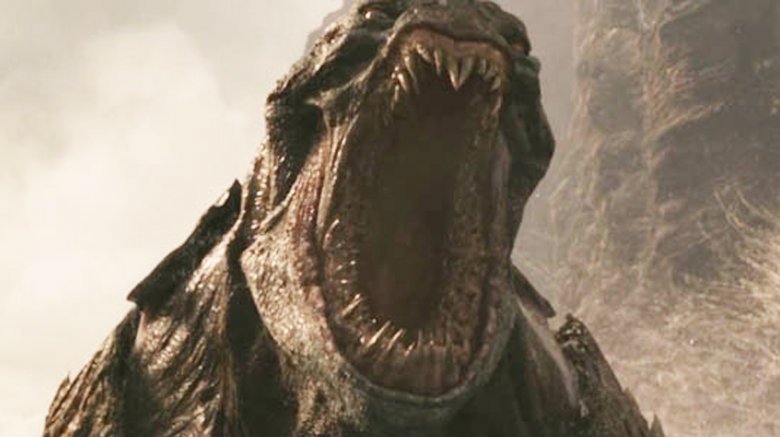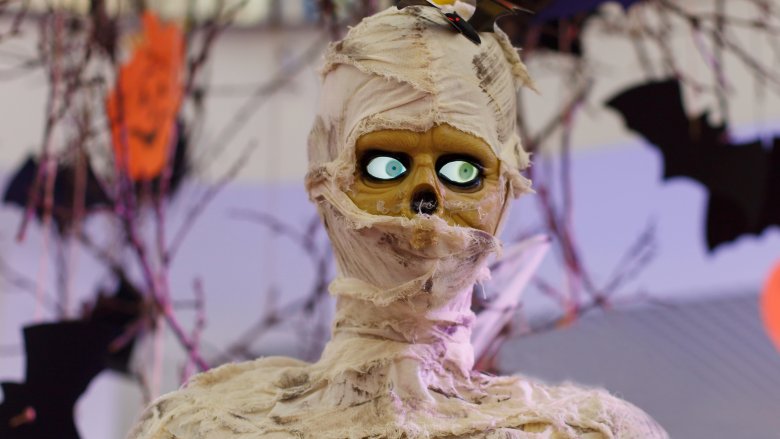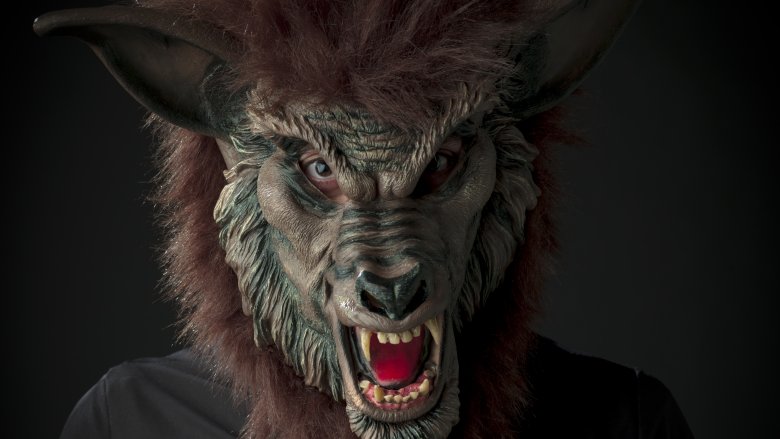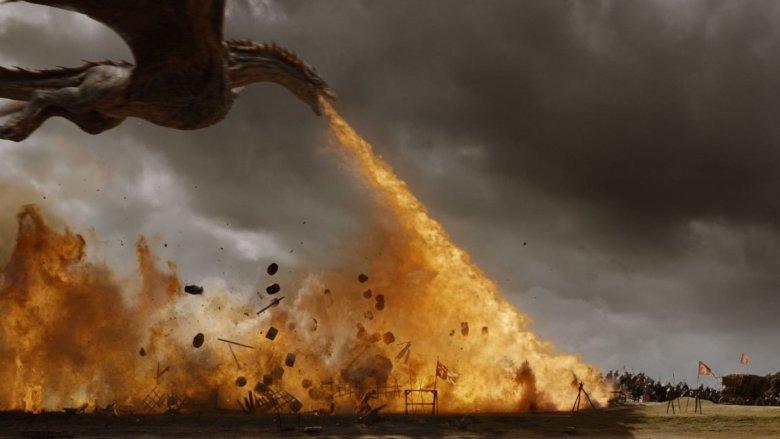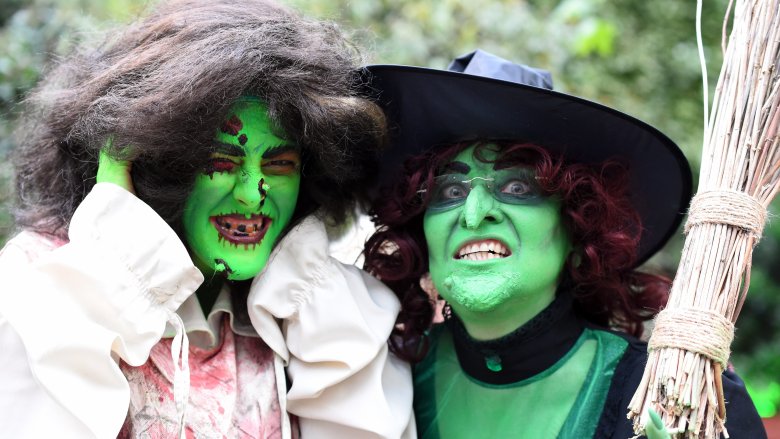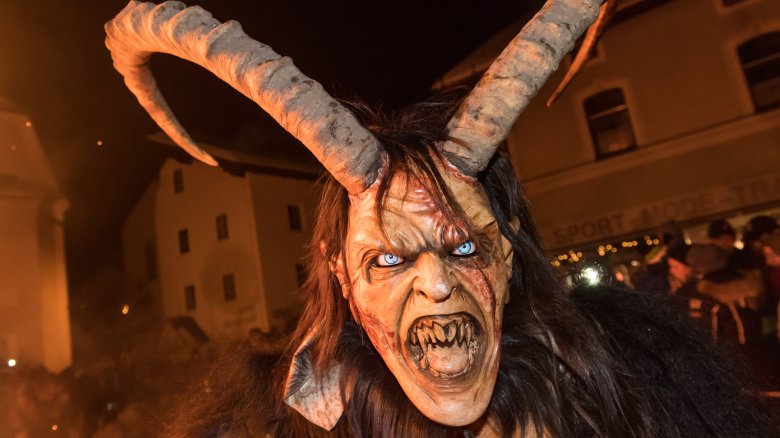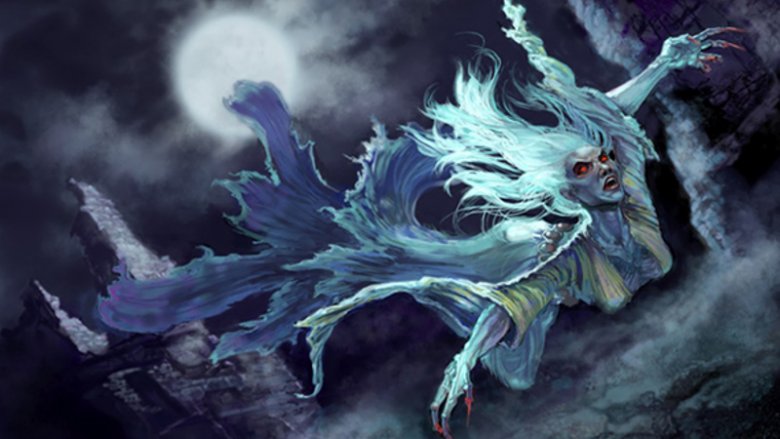The Origins Of Your Favorite Monster Myths
These days, monsters feel as American as apple pie. They star in our movies, and turn our Six Flags theme parks into Fright Nights. Tom Cruise fights them, and Kristen Stewart gets freaky with them. We treat them like a novelty, like something to give us a jolt, or smooth over an awkward first date.
But most of these creatures didn't begin on the big screen or in some YA novel. In fact, many are rooted in myths and legends that date back centuries, a few harkening to the very dawn of mankind. That's right, before we built our first huts and hovels or learned to grow our own food, we were telling tales about some of the same monsters starring in modern blockbusters.
The remarkable way these creatures have weaved their way through time, evolving and adapting to countless cultures, is a testament to the primal fears that first inspired them. While no two origin stories are the same, monsters all come from that part of us that fears the bump in the night. That knows, deep down, we are still just something else's prey. Here are just a few remarkable ways these monsters came into our world and have refused to leave ever since.
Cyclops roots come from elephant's snoot
As archaeologist Thomas Strasser sees it, bones may be the key to unlocking our most feared monsters of mythology. "You'll never be able to test the idea in a scientific fashion, but the ancient Greeks were farmers and would certainly come across fossil bones ... and try to explain them," he hypothesized to National Geographic.
Is this how the Cyclops was born, not from the loins of Greek gods Gaia and Uranus, but from a bed of soil tilled by ancient farmers?
Fossil evidence seems to indicate this as a likely explanation. Remains of Deinotherium giganteum, which loosely translates to "really huge terrible beast," are still being found on the island of Crete. An ancestor of the modern elephant, their skulls contain a large hole at the center, which would have attached to their profound nasal cavity. To an ancient farmer, this hole easily could have looked like a singular eye socket, spurring the legend of giants with one eye. Tales of these creatures would weave their way throughout Greek mythology, and most famously appear in Homer's Odyssey, cementing their place as the Jason Voorhees of Hellenistic times.
Real-life squid may have released the Kraken
For close to a millennium, it was accepted fact that sailing the open seas meant inviting the wrath of the mighty Kraken. A monstrous, squid-like creature, it was known to attack ships and devour their crews. From Norwegian lore to Liam Neeson meme, the Kraken has long been the oceans' most fearsome villain. So where did this murky monster of the deep come from?
Well, like many myths, it has its origins in the real world. Modern science has discovered dozens of different squid species that could fit the bill of the vicious Kraken. The largest, known as the Mesonychoteuthis hamiltoni, may be able to grow up to 45 feet long. Now, that's not as big as the Kraken was said to be, but it's nothing to sneeze at.
To an ancient sailor, seeing these rare animals must have been an awe-inspiring sight, one that would naturally need to be fluffed up with a little bit of blood and carnage. They would have no way of knowing that these enormous squid were more likely to spray a cephalopod ink cloud and flee than engage in a fight. In fact, their gargantuan arms lack muscle, so the chances of them devouring a ship are slim to none. But who cares about facts? Everybody loves a lethal legend, and with 95 percent of the world's oceans still unexplored, perhaps the killer Kraken is just biding its time and will someday return to wreak havoc on the seas.
Mummy mania only dates back one century
Unlike most monsters, mummies are real. Now, whether they're truly the cursed creatures of legend is up for debate, but they do exist. So how did these ancient corpses make the leap to lethal lore? Well, coincidence, and some movie magic, seem to be the culprits.
The discovery of King Tut's tomb in 1922 caused a sensation. This was the biggest thing since sliced bread (which wouldn't actually be invented for another six years), so it shouldn't come as a surprise that, when some prominent members of the discovery team started dying, it made some waves. The financier of the trip died from a mosquito bite. Houses burned down. One man died smothered in a "gentlemen's club." One British archaeologist hanged himself.
Feels spooky, although the number of deaths, statistically speaking, was not out of the ordinary. But it was spooky enough that Hollywood jumped all over it. Boris Karloff, Frankenstein himself, starred in the titular role of The Mummy in 1932, helping cement the idea of a cursed creature brought back to life through Egyptian mumbo-jumbo. The irony of this is the tomb had no such curse on it. In The Mummy's Curse, author Roger Luckhurst explained that Egyptian tombs were, "more likely to be blessed than cursed." In fact, it was the head of the Tut excavation team who "put out a story that a curse had been placed upon anyone who violated the rest of the boy-king," in order to keep people away from the discovery.
Werewolves come from the dawn of time
A mix of primal fears, real-life serial killers, and ravaging illnesses may have merged into the lupine legend, according to experts. The myth first popped up thanks to prehistoric man, who would often don the skins of its kills, and then wear them to hunt down other prey. These hunts would have been ritualized, and may have started the folklore of man and beast merging.
In addition, disease was once a mysterious force, wreaking havoc with no known causes or cures. For instance, rabies would drive wolves mad, sending them into the villages of America's Blackfoot people, where they would bite other animals and people. Unsurprisingly, those people would then, in turn, go mad. Sound like any myths you know? Or, a 1963 paper called, "On Porphyria and the Aetiology of Werwolves," suggested a rare genetic disorder could be the culprit for the werewolf myth. It caused "severe lesions brought on by exposure to light: The teeth turn red or brown, and as the years go by, structures like the nose and ears rot away. The affected go manic-depressive and hysterical and delirious."
Add in a series of famous serial killers, like Frenchmen Pierre Burgot and Michel Verdun, who supposedly swore allegiance to the devil and claimed they could turn into wolves, and you have a piecemeal approach to myth making. A little of this, a little of that, and the modern werewolf starts to appear. Now, who taught these hellbeasts how to moonwalk is another story entirely.
Dragons known thanks to a bunch of bones
Dragons are a marvel of myth making. They appear in virtually every culture, in every corner of the globe. From Sumer to China, Beowulf to the Bible, no ancient civilization was left untouched by these brutal beasts. So how did each culture, with their own rich histories and unique circumstances, all happen upon these monsters?
Well, Othenio Abel, an Austrian paleontologist, subscribes to one popular theory. Namely, bones. From sperm whales to pterodactyls, Ice Age woolly rhinoceros to ancient giraffes, there are a wide variety of extinct creatures that could easily have confused and inspired ancient men to make up these myths. Cave bears, for instance, had skulls that resembled the characteristics of a dragon-like head. They were found in caves, where much of dragon lore was centered, and some even formed big calcite crystals, which could have given rise to the bejeweled forehead many dragons were famous for.
Add in some real world reporting from the likes of explorers, like Marco Polo, who came back from China telling tails of real, live dragons, which most likely were just crocodiles, and you've got yourself a long-lasting, globe-spanning myth.
Witches' origin story tied to misogyny
It should come as no surprise that the mythology of the witch goes hand in hand with the misogyny of the rich and powerful. The idea of the witch, in one form or another, has been around since the very dawn of civilization, but their origins might surprise you.
According to biblical scholar Carole Fontaine, the first witches were in fact Middle Eastern "wise women" who served as doctors by making house calls, delivering babies, and helping to alleviate infertility and impotence. It wasn't until Hebrews settled in Canaan around 1250 B.C. that these priestesses and healers began to gain the more notorious associations they still carry with them today.
The Hebrews had a monotheistic and patriarchal belief system, and didn't have room for these lady doctors and their spiritual nonsense. So they did what powerful men have done wherever they've encountered strong women throughout history and outlawed them, forcing them to operate in the shadows. These "witches" became notorious criminals, feared for their feminine power, and soon became entwined with rumors of devil worship and murder. In fact, their vilification grew to such heights that the 16th and 17th centuries saw an estimated 60,000 women killed for being witches.
Zombies come from America's original sin
According to University of California Irvine professor Amy Wilentz, zombies have their origins in an unlikely place, namely the brutal history of slavery in the Americas. As she wrote in the New York Times, "suicide was the slave's only way to take control over his or her own body. And yet, the fear of becoming a zombie might stop them from doing so."
Haiti in the 17th and 18th centuries was a nexus of the slave trade, channeling hundreds of thousands of kidnapped men and women a year into a life of bondage. Most were put to work or shipped off to the highest bidder as soon as they reached the island. For many of these slaves, death was the only escape. The only way to get back to Africa, and freedom, was as a spirit. So you can imagine what a slave's version of Hell would involve, namely being trapped in their bodies, unable to die, and forever a slave.
These fears formed the foundation of the zombie myth, which was later appropriated and whitewashed by American filmmakers. While the genre has gone on to attack racism, consumerism and just about every other "ism" you can think of, it still often tips its hat to its Haitian roots, with movies from White Zombie to The Serpent and the Rainbow connecting the undead to their voodoo origins.
Demons are way weirder than you thought
Most people think they know where demons come from, and most people are wrong. Weren't they angels, cast out of Heaven along with their boss, the Devil? Well, surprisingly, there's no mention of this in the Bible, which is generally thought of as a fairly important book when it comes to Christianity.
So who are these demons, and where did they come from? Well, according to Michael S. Heiser, and his book The Unseen Realm: Recovering the Supernatural Worldview of the Bible, demons are actually, "disembodied spirits of dead ... giants who perished at the time of the great flood." Wait, what?
That's right, based on his research, the Dead Sea Scrolls are the key to unlocking this mystery, which has hints in the Bible, if never an emphatic answer. Basically, his theory is that angels and human women were boning and had a bunch of kids. Those kids were known as "Nephilim," but what they really were was a race of giants. Cool, right?
Because they were supernatural beings, some survived the great flood and started wreaking havoc on the new world. And when they died, these wicked creatures' spirits found no rest, and instead continued their nefarious ways in the underworld, now known as "the shades," or Sheol in Hebrew. If this Biblical hypothesis is correct, that means demons as we know them were once a bunch of gangster giants who terrorized the ancient world. And you always thought church was so boring, didn't you?
Banshees are a case of mistaken identity
It's becoming increasingly clear that monsters are often mankind's attempt to make sense of a world that was confusing and terrifying. Dig up some weird bones. Monster. Get sick from some unknown disease. Monster. Even ordinary sights and sounds can take on a foreboding nature under the right circumstances.
Most people don't think of the owl as a particularly fearsome animal, but like most things, context is key. For skittish soldiers preparing for war on the battlefields of ancient Ireland, the owl must have sounded like a monster. That's the theory, at least, on where Ireland's most famous spirit, the Banshee, comes from. Ancient battles were often begun at sunrise, meaning armies were marching just as those nocturnal owls were settling down from a long night of hooting.
The soldiers must have made a fearful sight for these tuckered birds, who would screech their ever-loving hearts out at the sight of them. Unfortunately, the screeches would have the unintended side effect of alerting the opposing armies that their foes were approaching, and a whole lot of death would follow. It's doesn't take much imagination to see how those hollers took on a legend of their own over the years and slowly morphed into the terrifying legend of the Banshee, a wicked fairy whose screams would herald death.
